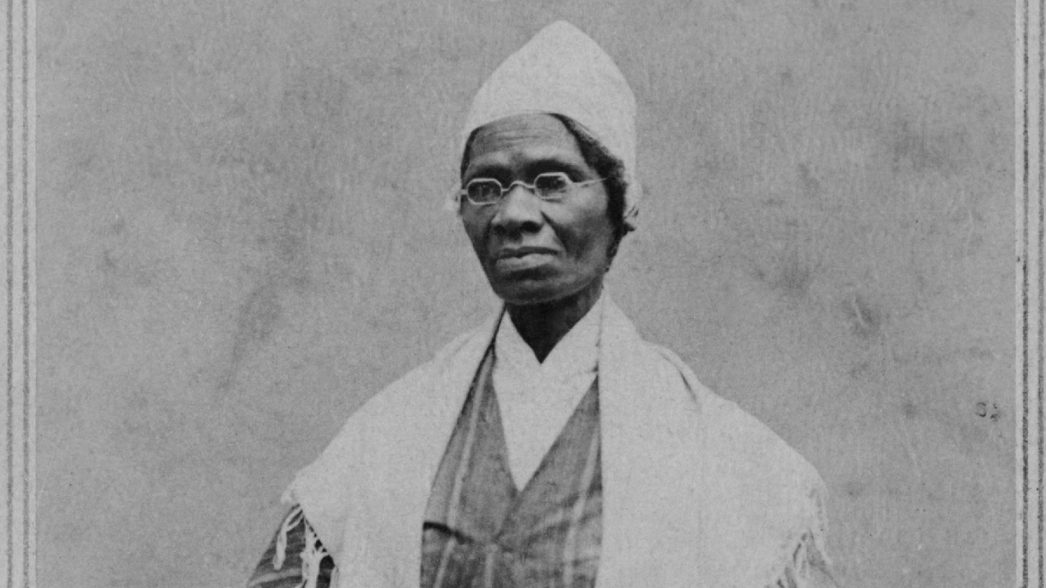Until you read a slave narrative or two you really don’t have any idea really, just how oppressive slavery was. How its vile sickness seeped into and touched every single aspect of a slave’s life. Most of us just think slavery was bad because of beatings or mistreatment like for example, you might’ve had a rude, ungrateful master and we compare that to having a rude, ungrateful supervisor at our job. That is how we relate to things, by comparing it to something we can personally relate to.
Rarely does the average American, black or white, have any idea how deep it went. And without that understanding, it is difficult to make sense of why blacks and whites have the relationships that they have today.
Sojourner Truth was born Isabella (“Bell”) Baumfree, one of twelve children, in 1797, on a farm in the town of Esopus, New York, 95 miles north of New York City. In 1806, when she was nine, her master died and she was auctioned off to pay his debtors for $100 and a flock of sheep. At the time of her sale she only spoke Dutch, not a word of English because Dutch was the language of her previous master. The man she was sold to, a Mr. John Neely, was a cruel man and while she was his property she suffered daily beatings. Neely eventually sold her to yet another owner and then she was sold to yet another until she finally settled with a man named John Dumont who was kind to her (by comparison), but whose wife was suspicious of his kindness towards Bell. As a result, his wife always treated Bell with disdain because she believed her husband had eyes for Bell.
But Bell didn’t have eyes for John Dumont. She had eyes for another. A slave named Robert who worked at a nearby farm. Robert’s master was a man named Charles Catton Junior. Catton was completely opposed to Bell and Robert having any sort of relationship because Catton knew that any children that came from their relationship would be property of Bell’s owner John Dumont, not his. Since he couldn’t benefit from owning their offspring he would be damned if he was going to watch some other person benefit. Slaves were money. Either they were worth money to you as labor or they were worth money because you sold them at auction. Each child, especially a male child, was potentially worth $20,000 in adjusted dollars for inflation today. If Bell and Robert had 5 children, let’s say, Catton saw that as him “giving” John Dumont guy $100,000.
Well, Bell and Robert were in love. And you know what young love does, right? They found a way to be together. The two of them would sneak off when the opportunity presented itself so that they could be together. Well one day Catton caught the two of them together and he beat Robert so badly that Robert ended up dying from his injuries from that beating.
Robert’s death was something that haunted Bell for the remainder of her life.
She ended up having five children total and it turned out that her Master’s wife knew her husband well because one of the children Bell gave birth to turned out to be John Dumont’s.
Slavery put black women in an awful helpless position. If your master wanted you sexually and you resisted there wasn’t a law in the land to protect you from whatever he wanted to do to you. In fact, as far as the law was concerned, it was legally impossible to rape a slave. This is why slaves, if they could help it, never married slaves from the plantation where they worked. It was just too hard to keep a marriage together if you knew first hand all of the humiliation and abuse that your spouse had to endure on a daily basis. It was better to work elsewhere and just live by the rule, “out of sight out of mind”. You don’t talk about what goes on at your plantation and your husband doesn’t ask.
Bell eventually ran away with her infant daughter in 1826 after John Dumont reneged on his promise to emancipate her on the condition that she continued to be a productive worker. He claimed that after she injured her hand that she hadn’t been as productive so he was no longer obliged to hold up his end of their agreement. Infuriated, Bell ran away expecting that within the year the State of New York would outlaw slavery and all of her children would be freed by New York State Law.
But out of spite, John Dumont ended up selling her son Peter, who was only five years old at the time, to another plantation deep into the South all the way in Alabama. With the help of her friends the Van Wagenens, Bell sued John Dumont in court for illegally selling her son. Since the State of New York was in the process of making slavery illegal there had been a moratorium in place on selling slaves out of the state.
Bell ended up winning her case in court after months of legal proceedings and won her son back. In doing so Bell became the first black woman to win a court case against a white man in American history. However, winning was bittersweet because it was only after she was reunited with her young son that she learned to what extent her young five-year-old son had been physically abused by his new owner in Alabama. Like the death of Robert, this too she never fully recovered from.
During her stay with her friends the Van Wagenens, Bell became a devout Christian.
When Peter was 17 in 1839, he got a job on a whaling boat. For two years Peter wrote his mother letters. When Bell received her third letter from Peter, he mentioned in the letter that he had sent her 5 letters and that he had never received a letter back from her. He was concerned why she had never written him back. This was alarming because Bell had written him 3, one for each letter that she had received from him. When Peter’s whaling ship returned to port in 1842 Peter was not on the ship and no one could tell her what happened to him. It was as if he simply disappeared from the face of the earth. She never heard from him again.
On June 1, 1843, Bell changed her name to Sojourner Truth, became a Methodist, and began her life traveling all over the North and preaching about the abolition of slavery. Why a Methodist? Methodists were among the first Christian denominations in America to forbid the buying and selling of slaves. Even in the south, Methodists from 1800-1830 had a reputation for having “a hatred for African slavery and many Methodists felt duty bound to preach against the institution on all occasions…” Most American churches raised few objections to slavery, with the exception of the Quakers, before the Great Awakening. But after the Great Awakening no denomination even came close to putting more effort and dedicating more resources to Christianizing enslaved Africans than the Methodist. An interesting side note is that while the Methodist put in the most effort, it was the Baptist, not the Methodist, who were most successful in Christianizing enslaved Africans. Mostly because Baptist slave owners in the south were the first to begin manumitting their slaves by the thousands after the Great Awakening. Think of it like brand loyalty. Particularly in the south, enslaved Africans associated emancipation with being a Baptist and that association stuck. I know this is over generalizing a bit but blacks, particularly free blacks in the north, tended to be Methodist while enslaved Africans in the south were generally Baptist. And so although Methodist tried much harder and devoted much more resources towards Christianizing enslaved Africans in the south they never came close to the success of Baptists.
Sojourner Truth (Bell) quickly became one of the most powerful and influential abolitionist speakers of her time. She travelled everywhere across the country speaking on the evils of slavery. Her memoir The Narrative of Sojourner Truth: A Northern Slave was widely read and sales from that book that afforded her enough money to purchase her own home.
But Truth was not only an abolitionist, she was also an unapologetic and proud feminist who was even better known for speaking on issues of gender inequality.
Once, in 1858, someone interrupted a speech she was giving and accused her of being a man; Truth then opened her blouse and revealed her breasts to a rounding applause.
In 1843 Bell left the Methodists and became a Millerite Adventist. Millerites were known for claiming that they could prove that Jesus Christ was going to return to the earth and reestablish his kingdom in 1844.
The year 1844 came and went.
Evidently, Jesus had better things to do.
So, No Jesus, No Bell. She left the group after Jesus failed to return and became a Seventh Day Adventist, which she would be until the day she died.
During the civil war she helped recruit black men to fight for the Union cause. After the war, she spent the rest of her years trying to secure land grants from the federal government for former slaves who emancipation had given freedom, but had also effectively made homeless and unable to provide for themselves and their families without going back to the very same men who had owned them before the war as sharecroppers.
Sojourner Truth died on November 26, 1883, at her home in Battle Creek, Michigan. She was buried at Oak Hill Cemetery in Battle Creek. More than 3,000 people crowded into the church for her funeral services to pay their last respects.
Most of us can’t relate to someone selling our five-year-old child off to another state and not being able to do a thing about it. Most of us can’t relate to someone murdering our boyfriend or girlfriend right in front of us and there not being any legal recourse to take against that person because he/she is well within their right to kill us at their whim.
What is more human than to fall in love?
Even falling in love with another person is subject to the approval of someone else.
The point is, the more damaging legacy of slavery is not, was not, and could never be the physical abuse one endured.

